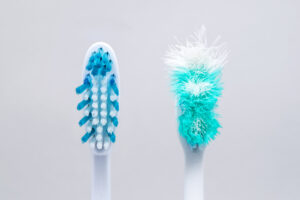In a world where cleanliness is paramount, the discovery of millions of bacteria on an item as intimately connected to our health as the toothbrush can be unsettling. Research from the University of Manchester has illuminated this microscopic universe, revealing that a single toothbrush can harbor over 100 million bacteria, including potentially harmful varieties such as E. coli and staphylococci. Yet, the question arises: should we be concerned about these bacterial inhabitants?
Read on to learn more about what is on your toothbrush and how you can safely and effectively brush and floss at home. Contact California Dental Group at 800-407-0161 for a dental appointment.
The Relative Risk of Toothbrush Bacteria
Surprisingly, the consensus among health experts suggests minimal risk from the bacteria festering on our toothbrushes. Considering the mouth’s natural ecosystem teeming with various bacteria, including plaque-forming types, the additional load from a toothbrush does not typically pose a significant threat. Our immune system is adept at handling such intruders, with greater concern associated with cross-contamination from sharing toothbrushes or aggressive brushing that may introduce bacteria beneath the gums, especially in those with weakened immune defenses.
Best Practices for Toothbrush Hygiene
Acknowledging the low risk doesn’t mean we should ignore toothbrush cleanliness. Maintaining a sanitary toothbrush not only aligns with good hygiene principles but also enhances the overall oral care experience. California Dental Group underscores the importance of following these guidelines for keeping your toothbrush in optimal condition:
- Avoid Proximity to the Toilet: Each flush can propel a bacterial mist into the air, potentially settling on nearby toothbrushes. Positioning your toothbrush as far from the toilet as possible and closing the lid before flushing can mitigate this risk.
- Sanitize the Toothbrush Holder: Often overlooked, the toothbrush holder is a hotbed for germs. Regular cleaning is essential to prevent your toothbrush from becoming contaminated by its storage environment.
- Ensure Toothbrush Dryness: Moist environments are breeding grounds for bacteria. After use, thoroughly rinse and dry your toothbrush upright, avoiding enclosed toothbrush covers that retain moisture.
- Refrain from Heat Sterilization: Though it might seem effective, using a microwave or dishwasher to clean your toothbrush can damage its bristles, compromising its cleaning efficacy. Instead, consider dipping the toothbrush in antibacterial mouthwash for sterilization.
- Regular Replacement is Key: Following the American Dental Association’s recommendation, replacing your toothbrush every three to four months, or sooner if you’ve been ill or notice wear, helps maintain a healthy brushing routine free from excessive bacterial buildup.
Contact Us Now for a Dental Cleaning and Exam
While the thought of millions of bacteria dwelling on a toothbrush may initially alarm, understanding the relative risk and adopting proper hygiene practices can alleviate concerns. By incorporating these simple yet effective strategies into your daily routine, you can ensure your toothbrush remains a tool for health, not a vector for illness. Trust California Dental Group for more insights and tips on achieving and maintaining optimal oral health. Remember, a clean toothbrush is integral to a healthy smile.


